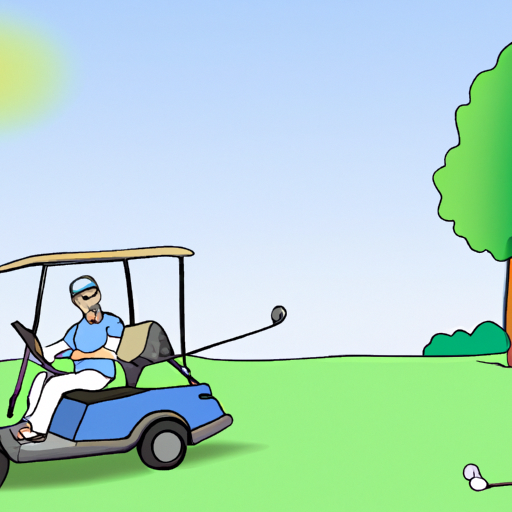- Home
- Golf Swing
- Bad Golf Swing
Mastering Your Swing: A Comprehensive Guide to Fixing a Bad Golf Swing
Are you tired of watching your golf ball veer off course every time you swing? Do you feel a pang of embarrassment every time you step onto the first tee, knowing that your swing is anything but perfect? You're not alone. Many golfers, myself included, have struggled with a bad golf swing.
But here's the good news: a bad golf swing isn't a life sentence. With understanding, practice, and a little bit of patience, you can turn your swing around.
I've been there, struggling with every slice and hook, feeling the frustration build up with every off-target shot. But I didn't let these setbacks deter me.
Instead, I took them as opportunities to learn and improve. I sought professional training, practiced diligently, and even invested in new equipment. Over time, I saw a significant improvement in my swing and my overall game.
Today, I can confidently step onto the course, ready to impress my buddies with my improved skills. And I want to help you do the same. In this guide, I'll share the secrets to fixing a bad golf swing, gleaned from my own journey and years of experience.
So, are you ready to transform your bad golf swing into a powerful, accurate, and consistent one? Let's get started.
 A golfer perfecting his swing on a sunny day.
A golfer perfecting his swing on a sunny day.My Journey: From Struggles to Success
As a weekend golfer, I've had my fair share of bad swings. There were times when I felt humiliated on the first tee, watching my ball veer off course.
But I didn't let these setbacks deter me. Instead, I took them as opportunities to learn and improve. I sought professional training, practiced diligently, and even invested in new equipment.
Over time, I saw a significant improvement in my swing and my overall game. Today, I can confidently step onto the course, ready to impress my buddies with my improved skills.
My journey wasn't easy, but it was worth every moment of struggle. I learned that persistence and patience are key in golf, and that every missed shot is a chance to learn and improve.
Are you ready to embark on a similar journey?
Understanding a Bad Golf Swing
A bad golf swing can be characterized by a lack of control, consistency, and power. It often results in the ball not going where you want it to go.
Common mistakes leading to a bad swing include improper grip, incorrect stance, and poor body alignment. Understanding these mistakes is the first step towards improving your swing.
A bad swing can lead to a variety of issues on the course, from slices and hooks to a lack of distance and accuracy. But by understanding what constitutes a bad swing, you can start to identify the areas where you need to improve.
Identifying a Bad Golf Swing
So, how do you know if you have a bad golf swing?
Look out for signs such as inconsistent ball flight, lack of distance, and discomfort during the swing. Video analysis can be a great tool to identify these issues. By recording and reviewing your swing, you can spot the areas that need improvement.
It's important to be honest with yourself during this process. It's easy to blame a bad shot on external factors, but the first step to improvement is acknowledging that there's room for improvement in your swing.
Common Struggles for Weekend Golfers
How do you fix a bad golf swing? Why am I struggling to turn in my golf swing? What do you call a bad golf shot? How should a perfect golf swing look?
These are common questions that golfers ask, and we'll address them in the following sections. These questions highlight the common struggles and concerns of golfers, and by addressing them, we can provide a comprehensive guide to improving your golf swing.
How to Fix a Bad Golf Swing
Fixing a bad golf swing involves understanding the mechanics of a good swing, identifying your mistakes, and then working on correcting them. Here are some techniques to help you improve your swing:
1. Grip: Ensure your grip is neither too tight nor too loose. Your grip should allow for control without causing tension in your arms. A good grip is the foundation of a good swing.
2. Stance: Your feet should be shoulder-width apart, with your weight evenly distributed between your feet. This provides a stable base for your swing.
3. Swing Plane: Imagine a plane that starts at the ball and goes through your shoulders. Your club should stay on this plane during your swing. This helps ensure a straight and accurate shot.
4. Follow Through: Make sure to complete your swing, with your body facing the target and your weight shifted to your front foot. A good follow through ensures maximum power and distance.
 A golfer demonstrating a perfect swing.
A golfer demonstrating a perfect swing.Preventing a Bad Golf Swing
Prevention is better than cure, right? To avoid developing a bad golf swing, follow these best practices:
1. Regular Practice: Consistency is key in golf. Regular practice helps you maintain a good swing and improve your muscle memory. Even if you can't make it to the course, practicing your swing at home can make a big difference.
2. Professional Guidance: Consider taking lessons from a certified golf instructor. They can provide personalized advice and correction techniques. Even a few lessons can provide valuable insights into your swing.
3. Physical Fitness: Golf requires strength, flexibility, and balance. Regular exercise can help improve these aspects and prevent a bad swing. Simple exercises like stretching and strength training can greatly improve your golf game.
Conclusion
A bad golf swing can be frustrating, but with understanding, practice, and patience, you can turn your swing around.
Remember, golf is a game of constant learning and adaptation. Each missed shot is a chance to learn and improve.
So, are you ready to transform your bad golf swing into a powerful, accurate, and consistent one?
Key Takeaways
1. A bad golf swing is characterized by a lack of control, consistency, and power.
2. Identifying and understanding your mistakes is the first step towards improving your swing.
3. Regular practice, professional guidance, and physical fitness can help prevent a bad golf swing.
4. With patience and persistence, you can transform your bad golf swing into a powerful and consistent one.
So, are you ready to take your golf game to the next level? Remember, the journey to a great golf swing begins with a single swing.
Everything You Need to Know About a Bad Golf Swing
How do you fix a bad golf swing?
How do you fix a bad golf swing?
Fixing a bad golf swing involves understanding the fundamentals of a good swing, identifying the flaws in your current swing, and then working on correcting those flaws. This can involve a variety of techniques, such as adjusting your grip, improving your posture, and practicing your swing mechanics. It's also beneficial to get professional advice from a golf instructor or coach.
Why am I struggling to turn in golf swing?
Why am I struggling to turn in golf swing?
Struggling to turn in a golf swing can be due to a variety of factors. It could be due to physical limitations, such as lack of flexibility or strength. It could also be due to technical issues, such as incorrect posture or alignment. Working on your flexibility and strength, as well as getting professional advice on your swing mechanics, can help improve your turn.
What do you call a bad golf shot?
What do you call a bad golf shot?
A bad golf shot is often referred to as a "duff," "shank," or "slice," depending on the specific nature of the shot. A duff is a shot where the ball doesn't go as far as intended, a shank is a shot that goes sharply to the right, and a slice is a shot that curves to the right in the air.
How should a perfect golf swing look?
How should a perfect golf swing look?
A perfect golf swing is one that is smooth, controlled, and results in the ball going where you intend it to go. It involves a good setup with proper alignment and posture, a smooth backswing where the club is taken back in a controlled manner, a good transition at the top of the swing, and a powerful and controlled downswing and follow-through.
What makes a bad golf swing?
What makes a bad golf swing?
A bad golf swing can be caused by a variety of factors, such as poor alignment, incorrect grip, improper posture, and flawed swing mechanics. These can result in inconsistent and inaccurate shots.
Who has the worst golf swing of all time?
Who has the worst golf swing of all time?
While it's subjective and can depend on personal opinion, some notable golfers are often mentioned for their unconventional swings, such as Charles Barkley and Jim Furyk. Despite their unique swings, they have still managed to achieve success in the game.
What are the most common golf swing mistakes?
What are the most common golf swing mistakes?
Some of the most common golf swing mistakes include incorrect grip, poor alignment, trying to hit the ball too hard, not rotating the body enough during the swing, and lifting the head too early to see where the ball is going.
How can I fix my golf swing?
How can I fix my golf swing?
Fixing your golf swing involves identifying the flaws in your swing, understanding the correct swing mechanics, and then working on correcting the flaws. This can involve practicing specific drills, getting professional instruction, and regular practice.
What are some good golf swing drills for beginners?
What are some good golf swing drills for beginners?
Some good golf swing drills for beginners include the half-swing drill for practicing swing mechanics, the alignment drill for improving alignment, and the tempo drill for developing a smooth and controlled swing.

















